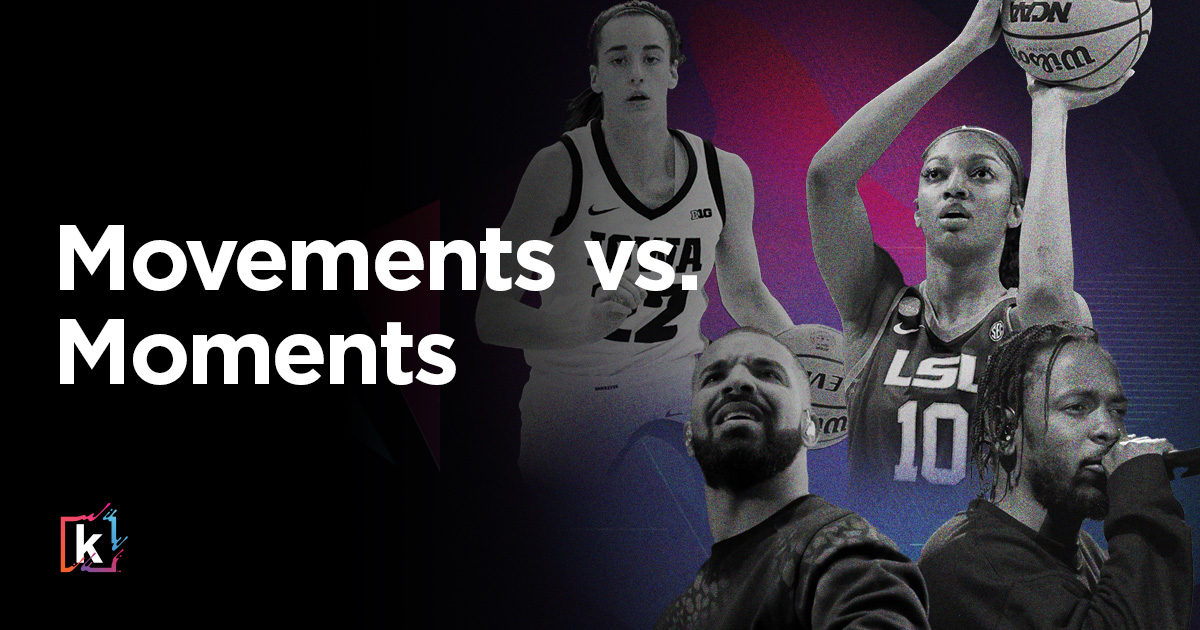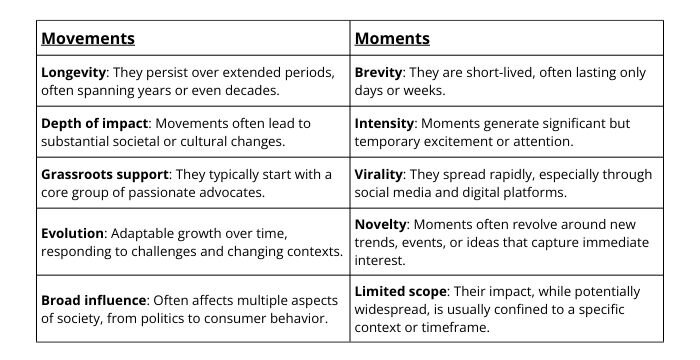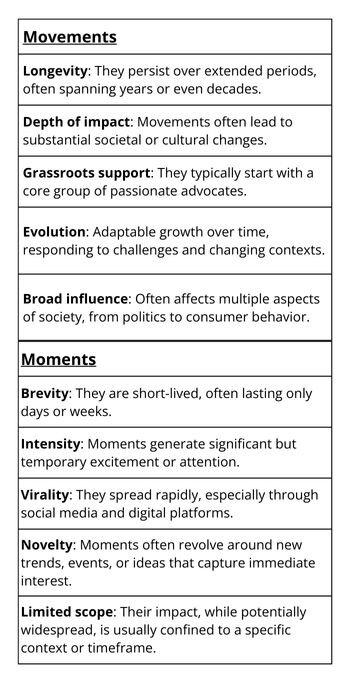Dope Thinkers Only: Movements vs. Moments


In the fast-paced world of popular culture and social media, the terms "movement" and "moment" are often used interchangeably. However, understanding the distinction between these two phenomena is crucial for marketers, brand strategists, and cultural observers alike. A moment can capture the public's attention fleetingly, while a movement has the power to reshape cultural narratives and consumer behaviors over time.
This blog post explores the key differences between movements and moments, using contemporary examples to illustrate their unique characteristics and impacts. We'll explore how figures like Caitlin Clark and Angel Reese in sports and Kendrick Lamar and Drake in music have sparked movements, contrasting their influence with moment-driven phenomena. By examining these cases, we'll uncover valuable insights into audience engagement, brand strategy, and the power of cultural resonance in today's dynamic marketing landscape.
Defining Movements and Moments
To understand the impact of cultural phenomena on marketing and consumer behavior, it's essential to clearly distinguish between movements and moments. A movement represents a sustained, often grassroots effort to promote specific ideas, values, or changes in society. Movements typically have a clear purpose, dedicated followers, and the potential to create lasting impact. They evolve over time, gaining momentum and adapting to challenges. Movements often transcend their original context, influencing various aspects of culture, politics, and consumer behavior.
In contrast, a moment is a brief period of intense focus or excitement around a particular event, person, or idea. Moments can generate significant buzz and capture public attention, but their impact is usually short-lived. They're characterized by their suddenness and often viral nature, spreading rapidly across social media platforms before fading from the collective consciousness.


For marketers, understanding this distinction is crucial. Aligning with movements requires long-term commitment and authenticity, while capitalizing on moments demands agility and quick action. Both can be powerful tools when used appropriately in marketing strategies.
Caitlin Clark & Angel Reese: Igniting a Movement in Women's Basketball
Caitlin Clark and Angel Reese represent the vanguard of a powerful movement in women's basketball, transcending their roles as individual players to become catalysts for change in the sport and beyond.
Caitlin Clark, the former sharpshooting guard from the University of Iowa and current guard for the Indiana Fever, has captivated audiences with her exceptional skills and record-breaking performances. Her impact extends far beyond the court, challenging long-standing gender disparities in sports media coverage and fan engagement. Clark's ability to draw massive viewership to women's basketball games has forced networks and advertisers to reconsider their approach to women's sports.
Angel Reese, the former LSU and current Chicago Sky Forward, brings a different but equally impactful energy to the movement. Known as the "Bayou Barbie,” Reese's confident on-court persona and unapologetic celebration of her success have sparked important conversations about double standards in sports. Her bold approach has resonated with a generation of young athletes who see in her the permission to be both fierce competitors and authentic individuals.
Together, Clark and Reese embody a movement characterized by:
- Unprecedented media attention: Their games and personal stories have garnered coverage typically reserved for men's sports.
- Challenging stereotypes: They're redefining perceptions of women athletes, showcasing strength, skill, and personality.
- Increased investment: Their popularity has led to more sponsorship opportunities and higher valuations for women's sports.
- Inspiring the next generation: Young girls see in Clark and Reese achievable models of athletic excellence and personal brand building.
- Driving social change: Their success has fueled discussions about equity in sports, from pay to resource allocation.
This movement presents unique opportunities for marketers. Brands that authentically align with the values of empowerment, equality, and breaking barriers can forge strong connections with a growing and engaged audience. The movement also challenges marketers to rethink traditional approaches to sports sponsorship and athlete partnerships, recognizing the immense potential of women's sports.
Kendrick Lamar: Cultivating a Cultural Movement
In the music industry, Kendrick Lamar stands out as an artist who has cultivated a genuine cultural movement. Lamar's impact goes beyond chart-topping hits; his work addresses complex social issues, sparks conversations about race and identity, and pushes the boundaries of hip-hop as an art form.
What distinguishes Lamar's influence as a movement:
- Artistic innovation: His work pushes the boundaries of hip-hop, incorporating complex narratives and diverse musical influences.
- Social commentary: Lamar consistently addresses issues of racial inequality, mental health, and social justice in his music.
- Cultural impact: His albums, especially "To Pimp a Butterfly" and "DAMN.," have become cultural touchstones, sparking widespread discussion and analysis in addition to his smash hit singles including “Alright” and more recently, “Not Like Us.”
- Educational influence: Lamar's lyrics are studied in academic settings, from high schools to universities, for their literary and social value.
- Industry change: His success has paved the way for more socially conscious and artistically daring approaches in mainstream hip-hop.
Lamar's movement demonstrates how artistic expression can drive cultural change. For marketers, this illustrates the power of aligning with artists and cultural figures who have a clear vision and the ability to inspire sustained engagement from their audience.
Drake: Mastering Moments in Pop Culture
In contrast to the movements sparked by Clark, Reese, and Lamar, Drake's career is characterized by his ability to create and capitalize on cultural moments. While undeniably influential, Drake's impact is often marked by short-term trends and viral phenomena rather than sustained cultural shifts.
Drake's moment-driven approach is evident in:
- Trend-setting releases: His surprise album drops and strategic singles create immediate buzz.
- Social media savvy: Drake's understanding of meme culture and viral content keeps him consistently relevant.
- Collaborative agility: His frequent collaborations with diverse artists allow him to tap into various cultural moments and fan bases.
- Adaptive persona: Drake's ability to shift his image and style helps him stay attuned to changing cultural moods.
- Cultural references: His lyrics often incorporate timely pop culture references, making his music feel immediately relevant.
Drake's strategy demonstrates the power of moments in capturing immediate attention and driving short-term engagement. For marketers, this approach can be effective in creating buzz around product launches or time-sensitive campaigns.
Implications for Marketers and Brand Strategists
Understanding the difference between movements and moments is crucial for developing effective marketing strategies:
- Long-term vs. Short-term Planning: Movements require sustained engagement and alignment with evolving cultural narratives. Moments call for agility and the ability to quickly capitalize on trends.
- Authenticity and Brand Values: Aligning with movements demands genuine commitment to certain values or causes. Moment-based strategies can be more flexible but risk appearing opportunistic if not executed carefully.
- Audience Engagement: Movements often foster deeper, more loyal connections with audiences. Moments can generate widespread but fleeting attention.
- Content Strategy: Movement-aligned content should be consistent and substantive, while moment-driven content needs to be timely and easily shareable.
- Influencer Partnerships: Collaborating with movement leaders like Clark or Lamar requires long-term commitment and value alignment. Partnering with moment-makers like Drake can be more casual but requires careful timing.
Final Thoughts
The distinction between movements and moments in popular culture offers valuable insights for marketers navigating the complex landscape of consumer engagement. While moments can create immediate buzz and short-term interest, movements have the power to shape long-term consumer behavior and brand loyalty.
Successful marketing strategies often involve a balanced approach, leveraging both movements and moments. By understanding the unique characteristics of each, marketers can craft more nuanced, effective campaigns that resonate with their target audiences.
As the cultural landscape continues to evolve, the ability to distinguish between fleeting trends and sustained cultural shifts will become increasingly crucial.
Brands that can authentically align with meaningful movements while also capitalizing on relevant moments will be best positioned to create lasting connections with consumers in our rapidly changing, fast-paced world.

